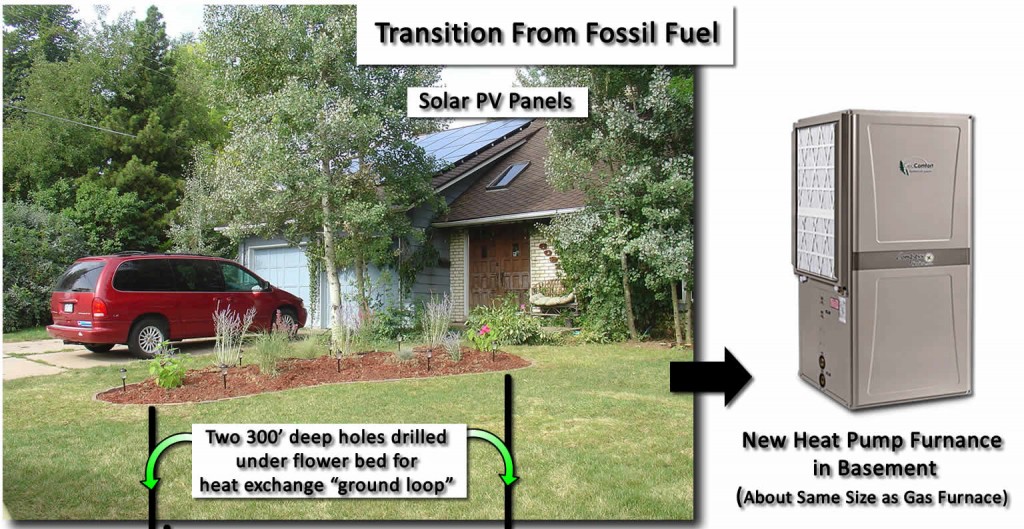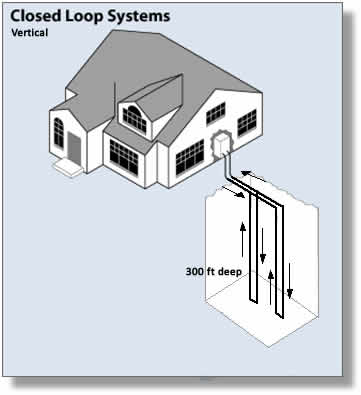Well folks, on Aug 29, 2011, we turned off the natural gas line to our home and became another of the growing number of homes around the Planet that are switching to Geothermal Heat Pumps (GHP) for heating and cooling needs. Free (of Fossil Fuel) at Last – at least for our home. Phase II of our Sustainable Energy Plan is now complete as Gail and I continue on our path seeking a more sustainable life style. (Next year we will address Phase III: Sustainable Energy for Transportation).
Our newly installed Geothermal Heat Pump (GHP) system is working great for both heating and cooling. And there is no longer a noisy A/C unit outside our dining room window, just a quiet compressor unit in the basement that we can’t even hear. Although the GHP can be used as a stand-alone system to replace one’s natural gas furnace, we are powering the GHP with our solar photovoltaic panels. As a result, we are no longer paying our utility company (Excel Energy) to provide electrical power or natural gas. Our home is now being run sustainably by harvesting the Current Sunlight and not by consuming Ancient Sunlight (i.e. fossil energy.)
And we haven’t had to make any significant changes to our “life style”
Our shift to Sun Farming using Solar Photovoltaic (PV) panels for generating electrical power began in June 2011 and was described in an earlier blog as Phase I of our Sustainable Energy Plan. Probably because the economy is so slow, and so many people are looking for jobs, we were able to transition from a fossil fuel home to a solar powered home in less than 6 months as contractors are eager to bid on these home projects.
Would we recommend this shift away from fossil energy to our friends? Absolutely.
So what is a Geothermal Heat Pump?
The Department of Energy provides the following description:
Geothermal Heat Pumps. Geothermal heat pumps (sometimes referred to as GeoExchange, earth-coupled, ground-source, or water-source heat pumps) have been in use since the late 1940s. Geothermal heat pumps (GHPs) use the constant temperature of the earth as the exchange medium instead of the outside air temperature. This allows the system to reach fairly high efficiencies (300%-600%) on the coldest of winter nights, compared to 175%-250% for air-source heat pumps on cool days.
While many parts of the country experience seasonal temperature extremes—from scorching heat in the summer to sub-zero cold in the winter—a few feet below the earth’s surface the ground remains at a relatively constant temperature.. Like a cave, this ground temperature is warmer than the air above it during the winter and cooler than the air in the summer. The GHP takes advantage of this by exchanging heat with the earth through a ground heat exchanger.
As with any heat pump, geothermal heat pumps are able to heat, cool, and supply the house with hot water. Relative to air-source heat pumps, they are quieter, last longer, need little maintenance, and do not depend on the temperature of the outside air.
Even though the installation price of a geothermal system can be several times that of an air-source system of the same heating and cooling capacity, the additional costs are returned to you in energy savings in 5–10 years. System life is estimated at 25 years for the inside components and 50+ years for the ground loop. There are approximately 50,000 geothermal heat pumps installed in the United States each year. more…..
Yes, it is an old “technology.” It uses the same technology as our electric refrigerators. You can look at a refrigerator as made up of three parts: 1) a coil inside the refrigerator that gets cold; 2) a compressor powered by electricity that circulates the refrigerant fluid through the coils; and 3) a second coil that is outside the refrigerator (in the back or underneath) that gets warm/hot and transfers heat to the air in the room – an ingenious method of transferring heat inside the refrigerator box to the outside.
In the cooling mode, the Geothermal Heat Pump system basically turns your whole house into a refrigerator because the second coil (called the ground loop) is located outside (actually underground below the frost line) where the ground temperature remains relatively constant at around 55° F year round in this part of the country. The ground loop in our case is 1200 lineal feet of 1 ¼” diameter black plastic tubing filled with water that carries the heat from our home and transfers it to the earth.
To heat your home, the system just runs backwards and takes heat from the earth and puts it into your home. There is no need to burn any gas, oil, coal, or wood for heat – you just exchange energy with Planet Earth.
According to the Department of Energy,
Economics of Geothermal Heat Pumps. Geothermal heat pumps save money in operating and maintenance costs. While the initial purchase price of a residential GHP system is often higher than that of a comparable gas-fired furnace and central air-conditioning system, it is more efficient, thereby saving money every month. For further savings, GHPs equipped with a device called a “desuperheater” can heat the household water. In the summer cooling period, the heat that is taken from the house is used to heat the water for free. In the winter, water heating costs are reduced by about half.
Although initially more expensive to install than conventional systems, properly sized and installed GHPs deliver more energy per unit consumed than conventional systems. And since geothermal heat pumps are generally more efficient, they are less expensive to operate and maintain — typical annual energy savings range from 30% to 60%. Depending on factors such as climate, soil conditions, the system features you choose, and available financing and incentives, you may even recoup your initial investment in two to ten years through lower utility bills. More…
Incidentally, 30% of the cost of installing a solar system for electrical power or a geothermal heat pump system for heating and cooling is currently being refunded to you via a federal tax credit intended to stimulate the transition to renewable energy.
Why are we so caught up in moving away from the consumption of fossil energy? Isn’t there a lot left?
Factoid: According to the Department of Energy, each year 50,000 homes are converted to Geothermal Heat Pumps – at that rate, all the 130,000,000 homes (ref: US Census) in the US will be converted in about 2000 years.
Of course with the current rate of consumption of fossil energy, we 7 billion people will have consumed all the coal, oil, natural gas, tar sands, shale oil, etc. in about 140 years from now (Ref: data from Worldometers.info.) To make matters worse, if one assumes a 1% increase per year in the consumption rate of fossil energy to account for global population growth and third world development, we will run out of this non-renewable reserve of Ancient Sunlight within 90 years. (See Excel spreadsheet for these calculations.)
Babies being born today may actually live in a world without fossil energy – unless we stop burning it now. That’s one reason to transition away from fossil energy today.
“But we can’t afford to move away from fossil energy financially – particularly today when the economy is so bad”
This is a frequent reason to avoid considering renewable energy.
Solar PV systems and Geothermal Heat Pump systems typically have a 10 year payback period using today’s economic model (which by the way is biased toward fossil energy) – meaning after 10 years of harvesting your own energy from Current Sunlight, your system is paid off from the energy savings and your home energy needs are being supplied free by the Sun (that as of today has not been privatized or patented).
The investment in renewable energy is significant and will typically amount to 10% of the value of your home. But harvesting your own energy is a responsible thing to do if you can, instead of borrowing the Ancient Sunlight from the Earth with no intention of ever paying it back so it is available for use by future generations. Just something to think about because alternatives to burning fossil energy are available today.
For those interested in more details, we’ve documented some “Observations/ Lessons Learned” from our experience installing a Geothermal Heat Pump – see our “Installation Report.” (PDF 4.2MB)
No Comments